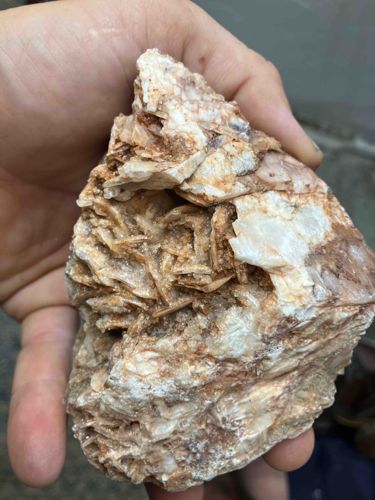
Desert Rose Gypsum Cluster
The item is a natural mineral formation known as a Desert Rose, most likely composed of gypsum. It is an irregularly shaped specimen, appearing to be of a size that comfortably fits within an adult hand, suggesting dimensions roughly between 4 to 6 inches in its longest axis. The predominant coloration is a blend of off-white and creamy tones, significantly intermingled with and encrusted by light to reddish-brown hues. These earthy colors are highly indicative of sand and iron oxide inclusions, which are characteristic of the arid environments where such formations typically occur. The most prominent feature of this specimen is its unique crystalline structure, which has naturally aggregated into distinct, radiating, blade-like or tabular crystal clusters. These clusters strongly resemble the delicate petals of a blooming rose, hence the common name 'Desert Rose'. Several individual 'rose' formations appear to be fused together, contributing to the overall structure of the larger specimen. The surface exhibits a coarse, heterogeneous texture, resulting from the layered gypsum crystals and the embedded granular sand particles. Upon close inspection, there are no visible signs of significant damage beyond what is typical for a natural specimen, such as prominent chips, breaks, or repair marks, indicating it is relatively intact and well-preserved. There are no manufacturing details, maker's marks, or signatures, as this is a naturally occurring geological phenomenon. This specimen's unique aesthetic appeal derives entirely from its natural geological formation over extended periods in specific climatic conditions.
AI-Generated Appraisal Disclaimer
Estimated Value
$50-75
Basic Information
Category
Mineral Specimen
Appraised On
November 29, 2025
Estimated Value
$50-75
Item Description
The item is a natural mineral formation known as a Desert Rose, most likely composed of gypsum. It is an irregularly shaped specimen, appearing to be of a size that comfortably fits within an adult hand, suggesting dimensions roughly between 4 to 6 inches in its longest axis. The predominant coloration is a blend of off-white and creamy tones, significantly intermingled with and encrusted by light to reddish-brown hues. These earthy colors are highly indicative of sand and iron oxide inclusions, which are characteristic of the arid environments where such formations typically occur. The most prominent feature of this specimen is its unique crystalline structure, which has naturally aggregated into distinct, radiating, blade-like or tabular crystal clusters. These clusters strongly resemble the delicate petals of a blooming rose, hence the common name 'Desert Rose'. Several individual 'rose' formations appear to be fused together, contributing to the overall structure of the larger specimen. The surface exhibits a coarse, heterogeneous texture, resulting from the layered gypsum crystals and the embedded granular sand particles. Upon close inspection, there are no visible signs of significant damage beyond what is typical for a natural specimen, such as prominent chips, breaks, or repair marks, indicating it is relatively intact and well-preserved. There are no manufacturing details, maker's marks, or signatures, as this is a naturally occurring geological phenomenon. This specimen's unique aesthetic appeal derives entirely from its natural geological formation over extended periods in specific climatic conditions.
Related Tags
Get Your Items Appraised
Instant estimates of your treasures with AI-powered instant appraisals